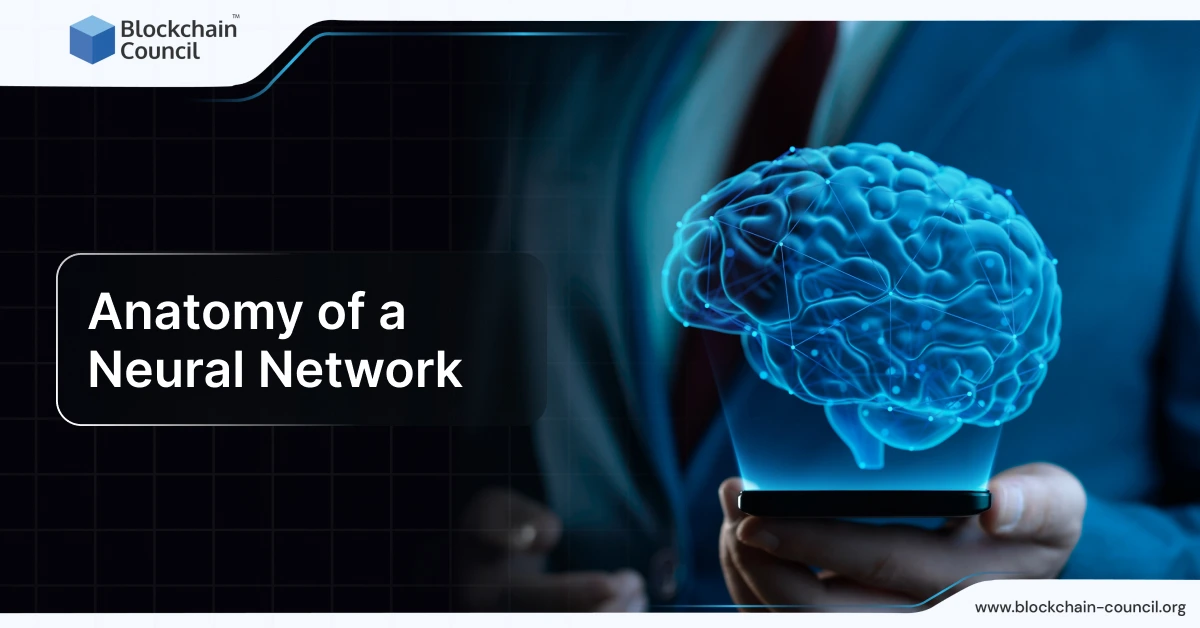
- Blockchain Council
- September 29, 2024
Neural networks are essential tools in artificial intelligence, mainly in machine and deep learning. They take inspiration from the human brain’s structure, where neurons connect to handle information. Although these networks can be complex, their main components can be simplified for better understanding.
Understanding Neural Networks
A neural network is made up of linked nodes, similar to brain neurons, that find patterns in data. A neural network has different layers. These include the input layer, hidden layers, and the output layer. Every neuron, or node, computes data, processes it, and sends the result to the next layer. This setup enables neural networks to learn and make decisions from the data they receive.
The primary concept is to simulate complex relationships between inputs and outputs. This is achieved through training, where the network tweaks its internal settings, called weights, to minimize the gap between predicted outcomes and real values.
Components of a Neural Network
- Input Layer: This marks the beginning for the network. Nodes in the input layer represent data features, such as pixel values in images or numerical data. This layer’s role is to transfer the information to the next layer without changing it.
- Hidden Layers: Computation occurs in these layers. Each node in a hidden layer gets input from nodes in the previous layer, processes it, and passes it forward. These layers are called “hidden” because their functions aren’t visible or easily interpreted. They apply weights to inputs, modify them using activation functions (like ReLU or sigmoid), and help the network understand complex data patterns.
- Output Layer: The final layer produces the network’s result, whether it’s a classification label, like identifying a dog in a photo, or a numerical prediction. The result depends on information processed through the hidden layers.
- Connections (Synapses): These links between nodes in different layers resemble brain synapses. They transmit signals between nodes and have weights that determine the strength and impact of the signals. Modifying these weights during training helps the network learn.
How Neural Networks Operate
Neural networks handle data by moving it sequentially through each layer:
- Input Stage: Data enters through the input layer, with each data point corresponding to a neuron.
- Weighted Calculations: Each neuron in the hidden layers computes a weighted total of its inputs. These weights are adjustable settings that determine the impact of each input.
- Activation Functions: After the weighted sum, neurons use an activation function to decide whether to pass their result to the next layer. These functions bring in non-linearity. This helps the network grasp patterns that are more complex than simple linear ones.
- Output Creation: After processing all layers, the output layer generates a final prediction or categorization based on the input.
Example of Learning: Backpropagation
Consider teaching a neural network to tell apart images of an eagle and a peacock.Initially, the network might guess randomly. Each incorrect guess prompts the network to adjust itself. This adjustment process, known as backpropagation, fine-tunes the weights until the network can consistently distinguish between eagles and peacocks. Over time, it identifies features like feather patterns or color, helping it improve accuracy.
Essential Components of Neural Networks
- Neurons: These serve as the fundamental units of a neural network. Neurons receive input, process it using mathematical functions, and produce output. Neurons are arranged in layers, and their connections control the flow of data.
- Weights and Biases: Weights define the connection strength between neurons. Changing these weights during training allows the network to improve and learn from the data. Biases are extra settings that shift the activation function’s output, adding more learning flexibility.
- Activation Functions: These functions control how neurons process inputs and decide on forwarding data. Common activation functions include:
-
- Sigmoid: Produces values between 0 and 1, useful for binary tasks.
- ReLU (Rectified Linear Unit): Outputs positive input values; otherwise, it’s zero, often used in hidden layers.
- Tanh (Hyperbolic Tangent): Produces values ranging from -1 to 1. It captures both positive and negative relationships effectively.
- Softmax: Converts outputs into probabilities, mainly used for multi-class classification.
These functions allow the network to manage different complexities in the data by incorporating non-linear aspects.
Training Process of Neural Networks
Training adjusts weights and biases to reduce the difference between expected and actual outcomes. This process, called backpropagation, works by calculating the error at the output and sending it back through the network, tweaking weights along the way. Optimization methods like gradient descent help refine these adjustments, enabling the network to learn patterns in the data gradually.
Types of Neural Networks
Neural networks differ depending on their design and use case:
- Feedforward Neural Networks (FNN): Information moves only forward, starting from the input and ending at the output. These systems perform effectively for things like identifying pictures or interpreting spoken words.
- Convolutional Neural Networks (CNN): Primarily used for image-related tasks, CNNs capture spatial data hierarchies, making them good for object recognition.
- Recurrent Neural Networks (RNN): Built for handling data sequences like text or time-based series. They retain information across steps, making them ideal for tasks needing context.
- Long Short-Term Memory Networks (LSTM): A specialized RNN that handles long-term dependencies. Commonly used in language models and time-sensitive contexts.
- Transformers: Advanced networks that use self-attention for data sequences, now standard in natural language tasks like translation.
Final Thoughts
Neural networks mimic brain processes to tackle challenging problems. By grasping their structure—input, hidden, and output layers, along with neurons, weights, and activation functions—you can see how they manage data. These models keep evolving, pushing boundaries in areas like healthcare and finance, showing their significant role in modern tech.





































































 Guides
Guides News
News Blockchain
Blockchain Cryptocurrency
& Digital Assets
Cryptocurrency
& Digital Assets Web3
Web3 Metaverse & NFTs
Metaverse & NFTs
